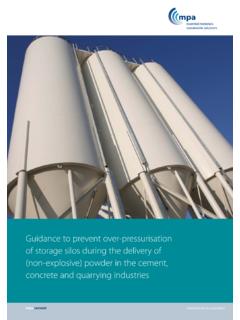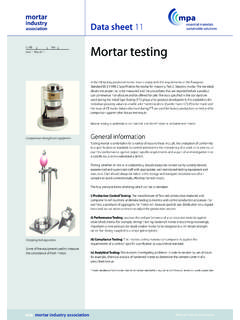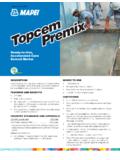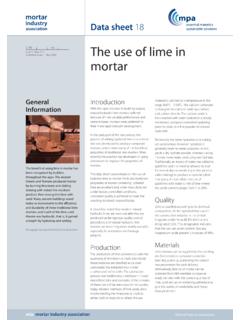Transcription of The UK cement industry aims to reduce greenhouse …
1 Mineral Products Associationmpa cement -62%-81%Scenarios for greenhouse gas reduction to 2050199020501990 to 2050 reduction under two scenariosThe UK is the first country in the world to legally commit to greenhouse gas reduction targets as far ahead as 2050. The target set is an ambitious one a cut of at least 80 per cent compared with 1990 levels. As an industry that emits CO2 , we are fully committed to playing our part and have already reduced our absolute CO2 emissions by over 55 per cent since 1990. We are now launching an ambitious new strategy to achieve an overall reduction of 81 per cent in greenhouse gases by 2050. This strategy sets out how we aim to achieve our goal and the support we will need along the UK cement industry aims to reduce greenhouse gases by 81% by 2050 Key facts Alternative waste-derived fuels replaced 40 per cent of the energy requirements from fossil fuels The industry is a net consumer of waste.
2 In 2011 it produced just 4,600 tonnes but consumed million tonnes as fuels and raw materials Emissions of oxides of nitrogen were down 59 per cent, sulphur dioxide down 84 per cent and dust down 82 per cent compared with to dateWe have been a world leader in our CO2 reduction drive to date. Since 1990, the UK cement industry has cut emissions faster and deeper than the UK economy as a whole and has reduced absolute CO2 emissions by over 55 per cent. The achievement is all the greater when you consider that some 60 per cent of our CO2 emissions arise when CO2 is liberated from the limestone, which is a critical and unavoidable part of the cement -making process. This huge reduction has been achieved through innovation, investment in efficient plant, closures and rationalisation.
3 Our members and this reportMPA cement is part of the Mineral Products Association, the representative body for the aggregates, asphalt, cement , concrete, lime, mortar and silica sand industries. It has three members that produce Portland cement and who have signed up to the targets in this report. They are: CEMEX UK Hanson cement Lafarge Tarmac In addition, associate members include Kerneos, a producer of aluminate cements and Quinn cement greenhouse gas reduction 1990-2050 Trajectories of two scenariosScenario 1 tCO2eScenario 2 tCO2e 1990-2010 emissionstonnes of CO2e05,000,0001990201020202030205010,000 ,00015,000,00020,000,0000500000010000000 1500000020000000-81%-62%GHG reduction vs 1990 cement = Portland cement equivalent11998 is the baseline year against which MPA members began reporting of these now?
4 We launched our first carbon strategy in 2005 as the British cement Association (BCA)2. Since then, the world has recognised the need for greater urgency in bringing down greenhouse gases, particularly CO2 . The UK is the only country in the world to have enshrined its greenhouse gas reduction targets in legislation looking out as far as 2050 and has set an ambitious target of reducing by at least 80 per cent against a 1990 baseline. The global cement industry was the first to develop a 2050 roadmap as part of the World Business Council for Sustainable Development cement sustainability initiative3. What counts is real action and the UK industry is clear on what it needs to do to help the UK achieve its ambitious targets. The opportunity is substantial.
5 We have, therefore, published a detailed strategy to reduce our CO2 footprint by up to 81 per cent to align with both UK and EU ambition. The full strategy can be accessed at strategy in summaryWe have identified two potential reduction scenarios: Scenario 1 81 per cent reduction Scenario 2 62 per cent reductionCrucially, the fundamental difference between the two scenarios is the more ambitious target anticipates carbon capture and storage technology not only being economically available in the cement industry but also being effectively deployed. Scenario 1 requires the huge technical and financial barriers of CCS to be overcome before CCS can be deployed in the cement industry . Scenario 2 is not without its own technical and financial scenarios require significant action by the industry , by Government and by others.
6 Our aim is, by working in partnership, to achieve an 81 per cent routeOur strategy is achievable through a combination of the following:Our commitment + actionSupport needed from Government and othersMore alternative waste-derived fuelsPolicies on the deregulation of waste that do not drive this valuable source of energy elsewhereMore carbon-neutral biomass fuelsPolicies put in place to maximize use by industryLower carbon cementsSpending that underpins locally sourced construction materials and drives growth in the construction sector such that investors can commit to the UK with confidenceFewer indirect CO2 emissions by improving electrical efficiency and by the decarbonisation of the electricity sectorElectricity costs must stay in line with those charged to our international competitors to stop production moving off-shoreCarbon capture and storageMust be made
7 Viable for the cement industry along with the required transport infrastructure and industrial storage sites readily available. The industry is carrying out extensive research at a European transport emissionsIncentives are needed to shift distribution transport to low carbon optionsRobust carbon accountingThe whole-life performance of a building must be the key measure rather than simply the embodied CO2 of its constituent products2 The British cement Association merged with the Quarry Products Association and the Concrete Centre in 2009 to form the Mineral Products Association. MPA cement is part of the Mineral Products In 2009, the International Energy Agency (IEA) and the WBCSD together developed a cement industry technology roadmap.
8 It outlines existing and potential technologies, and how they may help the industry support a halving of global CO2 emissions across all areas of business and waste-derived fuels Alternative fuels coupled with substantial investment in new technology, helped MPA members make significant reductions in each of their key emissions between 1990 and 2011. UK plants are now routinely using carbon-neutral fuels as a substitute for virgin fossil fuels. The range includes processed household and commercial wastes, solvents, scrap tyres, pelletised sewage sludge, and meat and bone meal. The common factor is that each has a high caloric value and would otherwise have gone either to landfill or incineration without energy recovery. Burning them in the highly controlled conditions of a cement kiln is safe and has no negative impact on the environment.
9 Alternative raw materialsWe have made good progress also in replacing virgin raw materials with a variety of substitutes. The waste streams used with success include construction waste, ceramic moulds, foundry sand, gypsum from plasterboard, mill scale, cement kiln dust, refractory bricks and road sweepings. The result of the impetus to date is that the industry recorded a per cent replacement of virgin raw materials in 2011 compared with capture & storageIn the long term, carbon capture and storage is seen as one of the biggest opportunities to make further large-scale CO2 emission reductions. Some early exploration work has been undertaken which shows that there are two types of technology that could work, but additional research is needed, and the heavy investment will not be justified until Government resolves the practical issues of transport and storage and the political issue of unequal carbon prices.
10 That is why the two scenarios we present are critically dependent on the deployment of CCS technology in the cement assumptions for the two scenariosUK production output10 Mt cementAlternative waste derived fuel (ie switching from virgin fossil fuels)80% thermal input by 2050 Biomass fuels and biomass fractions (ie renewable fuels that are either entirely or partially carbon neutral)40% of thermal input will be bio-alternative waste-derived fuel in 2050 Lower carbon cements (cements that contain lower embodied carbon) Mt cementCementitious substitution (ie reducing the amount of high energy cement clinker in the final cement mix)30% replacement by 2050 Decarbonisation of the electricity sectorTotal decarbonisation by 2050 to align with DECC ambitionScenario 1 Scenario 2 Carbon capture and CO2 capture by 20500Mt CO2 capture by 2050 Transport emissions (ie switching to lower CO2 transport modes and transport fuels)60% lower CO2e in 2050 Plant efficiency22% improvement in thermal efficiency by 2050 Delivering on our commitmentsThe key assumptions for our two scenarios are based on a normalised output of 10Mt : In order to compare like with like, output has been assumed to be 10 Mt cement equivalent per year for the milestones (set out in our full strategy document available at ).









